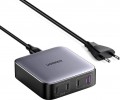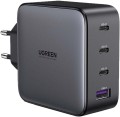Power (for all ports)
The total power provided by the device while simultaneously charging the maximum possible number of gadgets. This parameter is indicated only for models that can work with several gadgets; for a 1-socket charger or a wireless platform, the operating power is given in the “Power per 1 device” paragraph.
When evaluating this parameter, two points should be taken into account. First, when the charger is fully loaded, the power of each individual port and/or wireless platform may be lower than the maximum possible value. For example, some models with 2 USB ports for 2 A and 1 A (10 W and 5 W), with simultaneous operation of both ports, can output only 5 W each, that is, only 10 W in total (this is the number and indicated in this paragraph). Secondly, the distribution of power over individual connectors can be different — depending on the current on each port and supported fast charging technologies; these nuances are best specified in the official documentation.
Fast charge
Fast charging technology supported by the device.
By itself, fast charging, as the name suggests, reduces the charging time compared to the standard procedure. For this, increased voltage and/or current power is used, as well as a special smart process control. But the possibilities and features of such charging may be different, depending on the specific technology used in the device. The same technology must be supported by the charger too — this is the only way to 100% guarantee correct operation. However some types of fast charging are mutually compatible — this point should be clarified separately, and compatibility is not always full.
Nowadays, the following technologies are most widely used: Quick Charge of different versions (
3.0,
4.0, 5.0),
Power Delivery (
version 3.0 and
3.1),
Pump Express,
Samsung Adaptive Fast Charging,
Huawei Fast Charge Protocol,
Huawei SuperCharge Protocol,
OPPO VOOC,
OnePlus Dash Charge. Here is a brief description of each of them:
— Quick Charge (1.0, 2.0, 3.0, 4.0, 5.0). Technology created by Qualcomm and used in gadgets with Qua
...lcomm CPUs. The later the version, the more perfect the technology: for example, Quick Charge 2.0 has 3 fixed voltage options, and version 3.0 has a smooth adjustment in the range from 3.6 to 20 V. Most often, gadgets with a newer version of Quick Charge are compatible with more old charging devices, but for full use, an exact match in versions is desirable.
Also note that certain versions of Quick Charge have become the basis for some other technologies. However, the mutual compatibility of chargers and gadgets with support for these technologies needs to be clarified separately.
— Pump Express. Own development of MediaTek, used in portable devices with CPUs of this brand. Also available in several versions, with improvements and additions as it develops.
— Power delivery. Native fast charging technology for the USB-C connector. Used by many brands, found mainly in chargers and gadgets equipped with this type of connector. Presented in several versions.
— Samsung Adaptive Fast Charging. Samsung's proprietary fast charging technology. It has been used without any changes since 2015, so it looks rather modest compared to newer standards. Nevertheless, it is able to provide good speed, especially in the first 50% of the charge.
— Huawei FastCharge Protocol. One of Huawei's proprietary technologies. Formally similar to Quick Charge 2.0, but used with both Qualcomm and other brands of mobile CPUs, so compatibility is not guaranteed. In general, it is considered obsolete, gradually being replaced by more advanced standards like the SuperCharge Protocol.
— Huawei SuperCharge Protocol. Another proprietary technology from Huawei introduced in 2016; for 2021 is available in several versions. In some devices, the power of such charging exceeds 60 V — not a record, but a very solid indicator.
— Oppo VOOC. OPPO technology, used both in branded smartphones and in products from other brands. Available in several versions; The latest (for 2021) version of SuperVOOC is for 2-cell batteries and is sometimes listed as a separate technology called Oppo SuperVOOC Flash Charge.
— OnePlus Dash Charge. A relatively old proprietary standard from OnePlus. An interesting feature is that in some gadgets, the effectiveness of Dash Charge is practically independent of the use of the screen: when the display is on, the battery charges at almost the same rate as when it is off. Technically a licensed version of OPPO's VOOC, however, these technologies are not compatible. Since 2018, Dash Charge has been phased out by Warp Charge, but this newer technology is rarely used in separately sold chargers.
In addition, on the market you can find chargers that support rarer and more specific formats of work; the features of these formats can be clarified by special sources. Features
—
Operation indicator. In some models it also provides additional information about operating modes, malfunctions, etc. Most often, such a light indicator is in the form of a separate light or a clearly visible backlight system. And additional information can be provided by changing the colour of the backlight, by blinking, etc. However, even without these features, the operation indicator provides additional convenience in use. In particular, it allows you to determine whether the charger is receiving power and working normally — this can be useful when diagnosing various problems. It is also possible to use non-standard backlighting — for example, as a night light that makes it easier to navigate in an unlit room (especially since gadgets are often put on charge just at night).
—
Display. Own display on the charger case. This is usually the simplest screen with a few characters, but it is enough to display various additional information that makes life easier for the user: current voltage and current values, fast charging status, error codes, etc. On the other hand, this complicates the design, but in fact such information is required less often; Therefore, very few chargers with displays are produced.
— Detachable charger power cable. Cable for connecting the charger to the power source, which has a removable design. By itself, connecting to a power outlet using a separate wire (both re
...movable and non-removable) is rarely used in charger devices — mainly in devices for which the “plug on the case” type design is not suitable (this is primarily wireless models, as well as wired charger devices with an abundance of connectors and corresponding dimensions). Specifically, the removable design is convenient in two ways: firstly, the wire can be removed and compactly folded for storage and transportation, and secondly, if the cable is damaged, it can simply be replaced, no need to bother with repairs. The disadvantages include an increased probability of losing the cable, as well as a slightly lower reliability than with a non-removable design (the latter, however, becomes noticeable only with frequent connections/disconnections that wear out the connector).
— Non-detachable charger power cable. Cable for connecting the charger to the power source, rigidly fixed to the device and not intended to be disconnected. It occurs much less frequently than the removable one described above, since it is less convenient if necessary to compactly fold the device; and if the wire is damaged, most likely, you will have to carry the charger to a service centre. On the other hand, you can lose such a wire only together with the charger itself.Charger connection port
Port used to connect the power cable to the charger. This parameter is indicated mainly for wireless models, including car models (see "Type"), but it can also be relevant for other varieties — in particular, individual docking stations.
In general, when choosing, this parameter does not play a decisive role: a power adapter with the appropriate plug must be supplied in the kit. However, information about the power plug can be useful when looking for a spare or replacement power source. The options here might be:
— USB-C. One of the miniature varieties of the USB connector; microUSB differs from similar in many respects primarily in its two-sided design (which allows you to connect the plug to either side), as well as in smaller sizes. Is a universal standard; in fact, this means that, if necessary, you can also power the charger from a “non-native” adapter with a USB-C cable – the main thing is that this adapter can provide enough power.
— microUSB. Another smaller version of the USB connector, earlier than the USB-C described above. It is considered less perfect, and therefore noticeably less often used as a power connector for wireless charger; one of the key differences is the one-way connector design, which is less convenient to connect. MicroUSB is also a common standard and allows the use of third-party power supplies.
— Lightning. Proprietary 8-pin connector used in Apple technology. However, among the chargers there are...also third-party devices with such a power connector. The meaning of this design is that, if necessary, the charger can be powered through a proprietary Apple cable, and the Apple device can be charged wirelessly.
— Original. This category includes all connectors that are not related to those described above. These can be both proprietary interfaces of a particular company, or common, but at the same time rare standards. One of the most popular types of such a plug is cylindrical, similar to the DC power connector (although not necessarily identical in size and design). However, anyway, this connection method does not allow the use of third-party power adapters, and therefore is not particularly popular.

